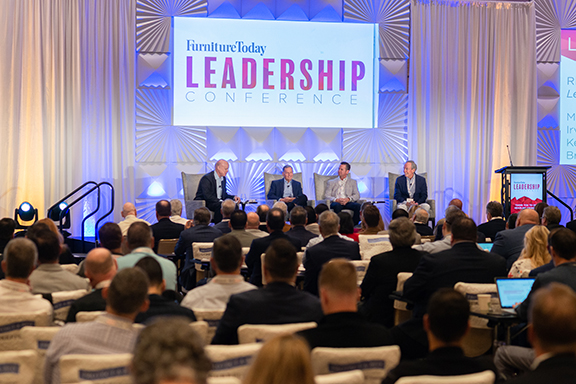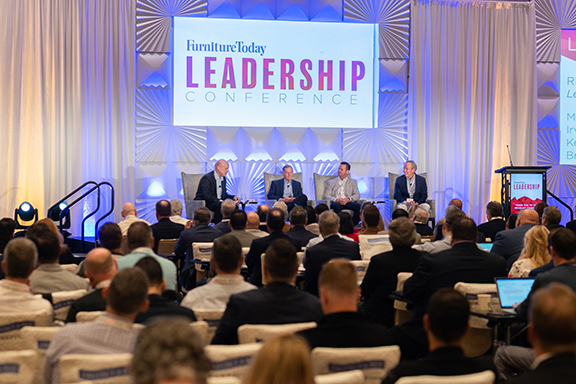 Clarence Smith, left, Havertys, Atlanta; Irv Blumkin, Nebraska Furniture Mart, Omaha, Neb.; Bryan Woods, Jerome’s Furniture, San Diego; and Keith Koenig, City Furniture, Tamarac, Fla. |
ORLANDO, Fla. — The four leaders on Furniture Today’s retail CEO panel have seen new brick-and-mortar competitors — sometimes each other — enter their markets recently.
But it became very clear during the recent Leadership Conference session that the real threat was everywhere online and represented in the audience: Amazon.
“In home furnishings, the big disruptor we have to pay attention to, even more than Wayfair, is Amazon,” said Keith Koenig, president and owner of Tamarac, Fla.-based City Furniture.
“Amazon is absolutely killing it at starting price merchandise. Wayfair is killing it (too) with enormous volume increase on very affordable furniture.”
City’s counter to this has included continuous investment in its digital platform and a shopping experience that pushes the inspirational envelope. Coming soon: an in-store augmented reality experience that can’t be duplicated online and assisted by tech-savvy sales associates guiding shoppers to view on store monitors large images of their rooms filled with City furniture and artificial intelligence-driven suggestions for coordinating rugs, lighting and other items.
The retailer also is changing up its assortment to give all-important Millennial shoppers what they are getting from Amazon and Wayfair — starting priced goods to go along with fashion-forward better goods, including more $200 sofas (eight today vs. two, when City made the conversion to a full-line furniture store in 1994).
Koenig’s comments came during the well-received morning session moderated by Clarence Smith, president, chairman and CEO of Atlanta-based Havertys, and also featuring Irv Blumkin, CEO of Omaha, Neb.-based Nebraska Furniture Mart, and Brian Woods, CEO of San Diego-based Jerome’s Furniture.
Woods agreed with Koenig’s take on Amazon, noting that last year, the debate was whether it was Wayfair or all the B2C bedding players posing the biggest threat, but “we’re seeing Amazon as the aggressive player going after low-price merchandise,” he said.
“Every one of these players in every form takes a piece of our pie,” added NFM’s Blumkin.
“They’re attacking us and being disruptive. You have to change, and you have to service the customer the way they want to be serviced.”
Digitally, “you have to be very aggressive,” he said. “If you stand still or stay in your traditional box, you won’t survive.”
Havertys has taken a multi-pronged approach to this and other competition that has included everything from a deep concentration on Havertys-branded product, to the bigger tickets that come from its growing complimentary design service and custom order business, to a better web experience that’s consistent with the store experience. The company’s biggest investment this coming year will be in IT, Havertys’ Smith said, and its biggest department by far is its IT staff.
More marketing dollars are going into mobile, social media and other electronic media, “and we’ve moved away from print,” he said.
The CEOs touched on many other topics top-of-mind for attendees here and other industry leaders as well.
Private ownership vs. public vs. private equity.
The panelists favored the private and public routes, with Koenig noting many private equity firms, although not all, have a record of buying, holding for a short period of time and saddling the businesses with debt before they collapse, taking employees with long careers down with them.
“They’re in the money business. We’re in the furniture business,” he said.
Smith noted how Havertys went public in 1929, just before the stock market crash, but in general it has been a positive arrangement.
“It’s an opportunity for us to let team members be a part of that,” he said, noting how Havertys managers and leaders receive stock grants, giving them the opportunity “to grow along with us.”
Public financial reporting has been good for the company, too, he added. “It makes us operate better. We’re more transparent.”
Blumkin’s Nebraska Furniture Mart, meanwhile, is in the unusual position of being part of a giant public company — Warren Buffett’s Berkshire Hathaway — while getting to operate like it’s not.
“That’s one of the secret sauces of Berkshire and Warren Buffett,” Blumkin told attendees. “He bought our business … 35 years ago on a handshake. Today, in our mind, and I think in our people’s minds, we think we own it 100%. We work like we own it 100%, and we get to do what we want to do.”
Woods, who leads the Navarra family-owned Jerome’s, said the company embraces that distinction, noting the cultural benefits that come with it and how the roughly 1,000 employees “consider the business part of their family” as well.
But he acknowledged the advantage of public and private equity ownership, too, seeing some of it firsthand in the Southern California, where Jerome’s is contending with Bain Capital-owned Bob’s Discount Furniture, which entered the market early this year.
“Private equity and public companies — they can invest much faster and deeper,” he said.
“But the other side of that is (family ownership) allows us to execute much faster.”
Big boxes vs. smaller stores.
Smith said Havertys stores once averaged about 55,000 square feet, but as the retailer expanded, it “couldn’t find the right economics” to open the larger stores. Now, the average is about 35,000 square feet.
“That’s the box we’re comfortable with, and with the Internet access to other products, we can extend the showroom.”
Blumkin’s NFM stores, meanwhile, range from about 450,000 square feet to 550,000 square feet, and he said he’s not sure he could operate in the confines of a 35,000-square-foot box.
“I think all companies have different paths to taking care of the customer,” he said. “Our path is just about destination, trying to dominate the categories we play in and giving the customer a great shopping experience.”
Smith received one of the biggest laughs of the hour when he asked Blumkin, “Are you going to open a lot more of those?” And then he went on to explain how NFM’s entry into the Dallas market a few years ago impacted Havertys’ performance there. Dallas used to be Havertys’ best market, he said. Now that title goes to Atlanta.
“If you don’t think it would affect your market, you’re wrong,” he said. “They opened a monster right in the best part of our Dallas territory, and it did affect us. We’re still there and still growing, … but it was an impact.”
What’s more important: store brand or supplier brand?
Most agreed that, over time, the store has become the more important brand. But how these retailers got there varied. For Havertys, roughly 20 years ago it was “almost out of necessity,” Smith said.
“We had always sold everybody else’s brand,” he said, adding that at one point, Havertys was the largest Lane, Thomasville and Broyhill dealer in the country. But as the conglomerate behind those brands began pursuing their own dedicated store strategy, effectively competing with Havertys, Havertys moved to develop its own product under its own name. Now everything it sells is either Havertys or co-branded.
City Furniture is largely the dominant brand in its namesake stores, but there are exceptions, Koenig noted, including Bernhardt, featured in in-store galleries, and Magnolia Home by Standard Furniture. City also operates Ashley Furniture HomeStores in South Florida.
Koenig said the question shouldn’t be whether or not consumers prefer product brands over store brands, noting the absence of powerful, trusted brands in this industry has given rise to the store as brand.
He drew an analogy between the current digital disruption of the furniture industry and the global marketplace disruption that occurred 25 years ago. Before the bulk of furniture production moved overseas, when consumers wanted to buy nice furniture they had no choice but to turn to certain manufacturer brands that were aligned with high-end furniture stores. And retailers such as City were relegated “to get whatever was left over” at lower price points.
“Globalization of the home furnishings industry disrupted it, and the brands didn’t follow the disruption very well,” he said.
“The message to all of us in retail is, if we don’t understand how we’re getting disrupted right now, we’re going to end up marginalized the way Thomasville and Drexel and a lot of those folks have been in the past number of years.”

